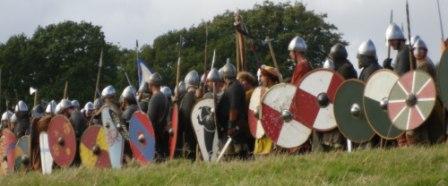In an earlier post, the Northern Powerhouse of 1065, I wrote about a northern revolt in 1065.
It was, however, only one of a long chain of north/south power struggles.

In those days, the Kingdom of England was more myth than reality – for hundreds of years, the territory we now call England was peopled with small kingdoms. There was Wessex in the south, Mercia in the midlands, the lands of Kent, South Saxons, East Saxons, and Northumbria. King Alfred the Great dreamed of being ‘King of the English-speaking Peoples’, but actually, he was king only of Wessex.
Northumbria – the land north of the River Humber, was founded by Anglo-Saxon invaders after the withdrawal of Roman Legions from Britain. It united two territories: Deira, roughly what is now Yorkshire, and Bernicia, the lands north of the river Tyne.
In 635, the king of Bernicia invited Aidan, a monk from Ireland, to found a monastery at Lindisfarne. Northumbria became Christian, and it was at Jarrow, in Northumbria, that the first known history of England was written, by Bede in the 730s.

But in 793, Vikings raiders struck Lindisfarne. It was the start of nearly three centuries of terror from the dreaded ‘Northmen’.
It would be wrong to consider the Viking raids as an attempt at conquest by a foreign state. Viking raiders were more like freelance pirates.
But these ‘freelancers’ were strong. Gradually, as years went by, they allied, raided for longer, began to stay in the country over the winter. They formed a ‘Great Heathen Army.’ (The Vikings were not Christians). The ‘heathens’ would have overrun the country, had not King Alfred fought his great turn-around battle of Edington in 878.

Alfred, however, was not able to oust the Vikings from the northern regions. He made a treaty with his adversaries, agreeing an area where the ‘laws of the Danes’ would hold sway. It was roughly a region north and east of a line from London to Chester.
Vikings settled densely in the former Deira, and this became the Viking kingdom of York. In the way of Vikings, they continued to fight amongst themselves. Sometime Kings of York originated from Scandinavia. Others were from a Viking dynasty based in Dublin.
The Vikings did not name themselves ‘Vikings’ – that meant, more or less, ‘pirate’. They called themselves Danes. Danes came from lands now named Sweden and Norway, as well as from Denmark.
Alfred dreamed of conquering all of England, but did not succeed. But in 927, his grandson, Aethelstan, fought and won a great battle at Brunanburh. He defeated an alliance from Scotland, Strathclyde and Dublin.
Brunanburh is a legendary battle, but its location has been a mystery. However, recent work by Wirral Archaeologists claims to have discovered the site, on the Wirral.
Brunanburh was a great battle, but two years later, Aethelstan died, and Vikings reclaimed the Kingdom of York. It was not until 954 that the last Viking king of York, Eric Bloodaxe, was killed.

Pic Wiki Media Commons
Eric was killed by the political manoeuvrings of one Osulf, who was Earl north of the Tyne – the ancient region of Bernicia. Few Vikings had colonised this area, and its Anglo-Saxon inhabitants had little love for the Danish invaders. Osulf eliminated his Norse rival and became Earl of Northumbria under the overlordship of King Eadred of England.
Although England was now officially united, it was very much a matter of local government, by the Earl, under the overlordship of the King, far away in Wessex.
And so things continued, until King Aethelred ‘The Unready’ (ill-advised) ordered the St Brice’s day massacre. On the King’s orders, Danish settlers in England were brutally murdered.
The massacre caused King Swein Forkbeard of Denmark to retaliate. He launched a series of attacks, culminating in the conquest of England in 1016. Then, he suddenly died, leaving his son Cnut to become King of England.

Pic Wiki Media Commons
Cnut took no chances. He began his reign with assassinations of anyone suspected of disloyalty – including the Anglo-Saxon Earl of Northumbria. He installed his own man, Eric Hlathir, shortly succeeded by one Siward Digera, ‘The Strong’.
Siward took the precaution of marrying into the family of hereditary earls, and successfully ruled Northumbria for over twenty years. Cnut affirmed that the ‘laws of the Danes’ would hold sway there.
Few written records survive, but it appears that the ‘Laws of the Danes’ included setting tax rates. And they were significantly lower than in the southern regions.
There could be many reasons for lower taxes in the Danelaw. It may be that northern lands were less productive. It may be that taxes in Wessex and Mercia got high due to the immense ‘Dane geld’ payments that Aethelred ‘The Unready’ made – fruitlessly – for the Danes to leave.
Whatever the reasons, these differences set the scene for trouble when southerners tried to rule Northumbria.
For further reading, I recommend “The Norman Conquest of the North’ by William E Kapelle.
